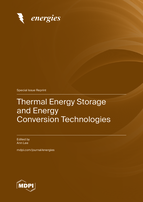Thermal Energy Storage and Energy Conversion Technologies
A special issue of Energies (ISSN 1996-1073). This special issue belongs to the section "J: Thermal Management".
Deadline for manuscript submissions: closed (31 May 2023) | Viewed by 20661
Special Issue Editor
Special Issue Information
Dear Colleagues,
I would like to extend a warm invitation to all colleagues who would like to submit their research papers to the Special Issue of Energies on “Thermal Energy Storage and Energy Conversion Technologies”.
Thermal energy storage (TES), also known as heat storage systems, is a technology that accumulates energy when production exceeds demand so that the stored energy can be used later. The stored energy can be used at the user’s request for heating and cooling applications or for power generation. TES systems are commonly seen in buildings and industrial processes.
On the other hand, conversion and storage, such as solar and wind energy, helps to further increase the share of renewables in the energy mix. TES is becoming crucial for electricity storage in combination with solar power, whereby solar heat can be stored for electricity production when sunlight is absent.
This is a special issue dedicated to recent advances in thermal energy storage and energy conversion technologies. All types of research approaches are equally acceptable: experimental, theoretical, computational, and their mixtures; papers can be both of fundamental and applied nature, including industrial case studies. Solutions for challenges surrounding clean energy solutions and cold chain technologies are also welcomed.
Dr. Ann Lee
Guest Editor
Manuscript Submission Information
Manuscripts should be submitted online at www.mdpi.com by registering and logging in to this website. Once you are registered, click here to go to the submission form. Manuscripts can be submitted until the deadline. All submissions that pass pre-check are peer-reviewed. Accepted papers will be published continuously in the journal (as soon as accepted) and will be listed together on the special issue website. Research articles, review articles as well as short communications are invited. For planned papers, a title and short abstract (about 100 words) can be sent to the Editorial Office for announcement on this website.
Submitted manuscripts should not have been published previously, nor be under consideration for publication elsewhere (except conference proceedings papers). All manuscripts are thoroughly refereed through a single-blind peer-review process. A guide for authors and other relevant information for submission of manuscripts is available on the Instructions for Authors page. Energies is an international peer-reviewed open access semimonthly journal published by MDPI.
Please visit the Instructions for Authors page before submitting a manuscript. The Article Processing Charge (APC) for publication in this open access journal is 2600 CHF (Swiss Francs). Submitted papers should be well formatted and use good English. Authors may use MDPI's English editing service prior to publication or during author revisions.
Keywords
- energy storage
- energy conversion
- thermal shock
- melting
- solidification
- enthalpy formulation
- phase change material
- clean energy






